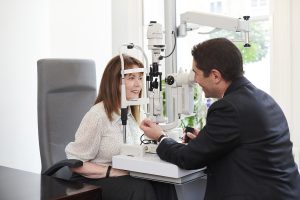How Do Your Eyes Recover After Laser Eye Surgery?

There are many things to consider when deciding whether to go ahead with Laser Eye Surgery. Alongside the costs involved and choosing the right clinic and surgeon, it is also important to be fully informed about what you can expect throughout your recovery. At London Vision Clinic, we’re dedicated to providing helpful resources to help you make a more informed decision regarding your treatment.
So, whether you’re interested in learning more about the different Laser Eye Surgery treatments available, the difference between independent and high-street clinics, or how soon you can be back to work, you’ve come to the right place.
In this article, we’re taking a closer look at the recovery process. We’ll focus on how Laser Eye Surgery changes and affects the eye, including how the eyes recover post-surgery. Read on to learn more about the amazing healing power of your peepers!
What Happens to the Eye During Laser Eye Surgery?
Since its introduction over 30 years ago, Laser Eye Surgery has grown to become the most popular elective procedure in the world. In fact, more than 100,000 people undergo the procedure every year in the UK alone! And yet, many people (understandably) don’t really know how the treatment works. To better understand how Laser Eye Surgery changes our eyes, we first need to understand the causes of common refractive errors like hyperopia (long-sightedness), myopia (short-sightedness) and astigmatism.
What Causes Refractive Errors?
Refractive errors occur when light is not effectively focused on the retina – this can happen for a number of reasons:]
- Myopia—the most common refractive error—occurs when the eyeball is too long from front to back or when the cornea is more curved than it should be. This causes light to be focused in front of the retina.
- Hyperopia occurs for the opposite reason: the eyeball is too short, or the cornea is too flat, causing light to be focused beyond the retina.
- Astigmatism occurs when the eyeball is abnormally shaped: rather than being round, like a football, astigmatic eyes are slightly squashed along one axis – more like a rugby ball. This causes light to be reflected on two points on the retina, resulting in blurred or distorted vision.
All vision correction aids aim to make up for the shape of the eye by changing how light is reflected into it. Glasses and contact lenses achieve this by applying an external lens; however, Laser Eye Surgery involves changing the shape of the eye (or at least the cornea) itself.
Changing the Shape of the Cornea
During your treatment, ultra-precision lasers are used to either remove a section of the corneal epithelium (surface layer) as in PRK/LASEK, create a small flap in the cornea like in LASIK, or make a small keyhole incision as done in ReLEx SMILE. Each of these techniques allows your surgeon to access the corneal bed beneath.
A second laser is then used to remove a pre-determined area of corneal tissue. Contrary to popular belief, these lasers are not hot and do not burn the tissue. Instead, they use ultraviolet light to break down bonds in the tissue, allowing us to reshape the cornea. Thanks to the use of anaesthetic eye drops and highly precise lasers, this process isn’t painful and is extremely fast.
However, the procedure does cause some trauma to the eye, triggering its natural inflammation response. So, what happens during this response and how does the eye recover after Laser Eye Surgery?
What Happens to Your Eyes After Laser Eye Surgery?
During LASIK – the most popular Laser Eye Surgery procedure – the surgeon will create a “flap” on the surface of the cornea. This will be put back in place as soon as the treatment is complete, at which point healing begins immediately. Similarly, the keyhole incision created in SMILE will start to heal almost instantaneously. During this healing time, which typically takes around 2 – 6 months, it is common to experience some side effects, including:
Fluctuating Vision
Part of this healing process involves a rush of fluid to the treatment area, which causes swelling in the eyes. This response is completely normal, but it is associated with several side effects such as blurred or fluctuating vision. These effects are usually nothing to worry about and will resolve themselves as the swelling reduces and your eyes heal.
Dry Eyes
Laser Eye Surgery can also temporarily affect your eyes’ tear film, leading to dry eyes. Again, this is a completely normal response to the treatment. Moreover, administration of lubricating eye drops (provided by the clinic) is usually sufficient to manage this symptom.
Mild Discomfort
Immediately after your treatment, as the anaesthetic drops begin to wear off, you may experience some discomfort in your eyes. This is often described as a “grittiness”, as though you have an eyelash in your eye. However, it is extremely important to avoid rubbing your eyes in the days after your treatment, as this can risk dislodging the corneal flap or otherwise disrupting the healing process.
A Temporary Inconvenience
As mentioned above, all of these side effects should be temporary and easily managed. In the majority of cases, patients notice an improvement in their vision and most post-operative symptoms within a few days to a few weeks after their treatment. However, in a small number of cases, side effects may persist for longer. It is important to attend your scheduled post-operative appointments so your surgeon can keep track of your recovery and make any necessary adjustments to your aftercare regime.
The eyes are incredible organs with surprising resilience. Their healing power means that most patients can return to many normal activities within just a few days of their treatment. To learn more about Laser Eye Surgery recovery, get in touch with one of our friendly clinic coordinators – we’re always on hand to help! Alternatively, Book a Consultation to kickstart your Laser Eye Surgery journey today.


